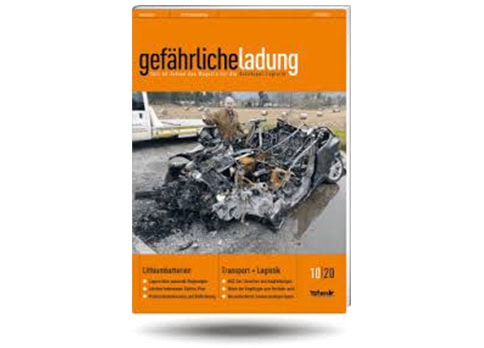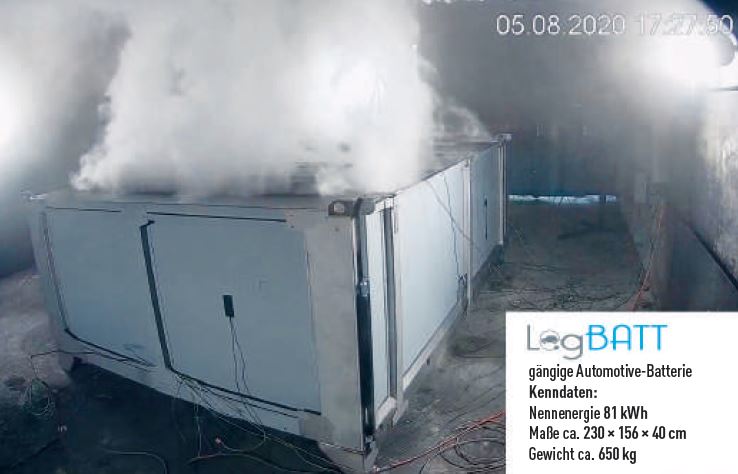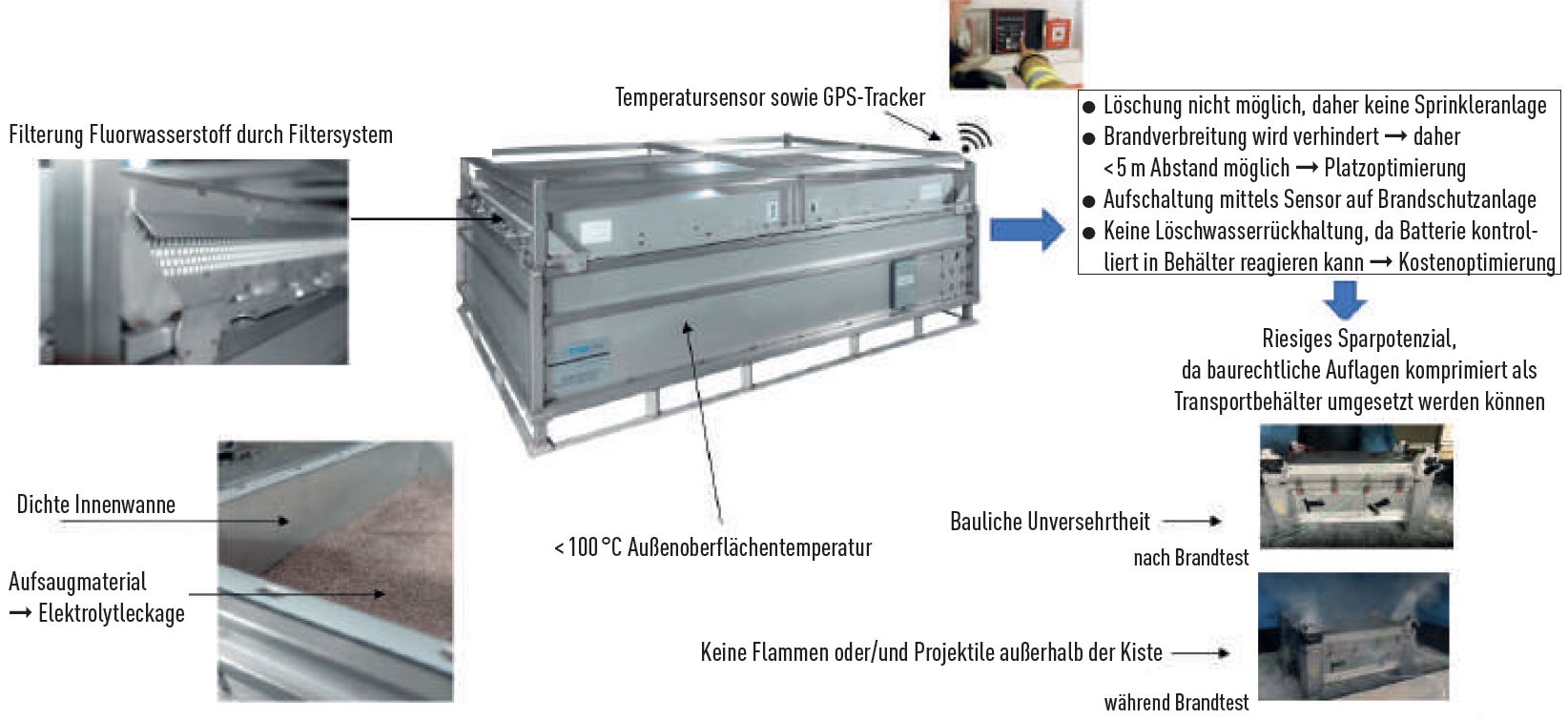
In the current issue of the magazine: “gefährlicheladung” the managing director of LogBATT GmbH Philipp Helmle had the opportunity to write a technical text. The article: “What is good for the road…” deals with the storage of lithium batteries, for which – in contrast to the transport law ADR – there are no legal regulations yet. Mr. Helmle writes about the construction law aspects as well as the dangerous situation in the industrial sectors. He comes to the conclusion that the solutions under dangerous goods law could be transferred to storage. Thus, the necessary legal requirements and guidelines could be created for this sector.
What’s good for the road…
… cannot be so wrong for STORAGE. The article deals with the storage of lithium batteries, for which – in contrast to the transport law ADR – there are no legal regulations yet.
The fact that lithium-ion batteries present new opportunities through their technology, but also challenges and dangers, is no longer a secret and has already been described in many technical articles. However, since we can now no longer speak of a temporary fringe technology, but of a mass market which, despite the Corona crisis, is growing with incredible force and at a dynamic pace, more and more stakeholders and their organizations are being confronted with new challenges at the same time and worldwide.
The incredible dynamics can be seen very well in the dangerous goods regulations of the ADR that have grown over the years with regard to lithium-ion batteries, which have even managed to get their own danger label (9A). The fundamental beauty of this legal regulation – the sense and reasonableness of some requirements can be discussed at length – is that one can orient oneself legally. As soon as someone is on public roads, the ADR applies. So far, so clear.
The situation is different when it comes to internal transport and, above all, storage. Who can help you here, and what can you use for guidance? The obvious choice would be the legislation on hazardous substances, or more precisely the Technical Rules for Hazardous Substances (TRGS) – but lithium-ion batteries, as objects, are not formally covered by this. So what can be done? Wait until one day this will be regulated? Probably not, safe solutions are already needed now, apart from the fact that the laws lag behind battery technology and the dynamics of distribution anyway.
However, it is not always necessary to reinvent the wheel. It is worthwhile to take a look at possible solutions that are based on existing dangerous goods legislation.
Building law aspects
If one looks at the requirements of the individual building authorities regarding the approval of storage facilities for lithium-ion batteries, the following protection goals are often pursued – in brief:
- Preventing the outbreak of a battery fire,
- Collection of contaminated extinguishing water.
As a concrete implementation, a separation of the premises is often required, i.e. only lithium-ion batteries may be stored in certain sections and nothing else. In addition, these sections are then often limited to a certain amount of batteries, usually by total weight.
In addition, to contain a potential battery fire and prevent it from spreading to adjacent batteries, special requirements are placed on sprinkler systems. The current best method of fire suppression is to use the cooling effect of water to slow the reaction in the batteries. In addition, adjacent areas are often provided with F 90 walls, doors and gates to prevent a fire from spreading to the entire building as far as possible.
Many of the conditions mentioned can be taken from the leaflet VdS 3103:2019-06 (03) of the German Insurance Association (GDV), which is often mentioned and quoted in connection with storage and to which, of course, the property insurers and also the authorities refer. However, this already reveals the first topics that are not yet regulated, such as for prototypes or batteries with high power.
Storage in safety cabinets
Increasingly, solutions are also being found in the storage area that make use of existing F 90 safety cabinets for hazardous substances. If you take a look at the requirements, for example from the DIN 4102-2 standard (fire behavior of building materials and components) for achieving fire resistance class F 90, it quickly becomes clear that this approach only corresponds to the real conditions to a limited extent. In this case, a defined fire from the outside is intended to ensure structural integrity over a certain time and temperature course. As real tests have shown, battery reactions can occur within a few seconds or minutes, with large quantities of smoke gas being emitted abruptly. The battery fire also occurs from the inside out, rather than from the outside in.
Real fire test of an electric car drive battery in a storage box (SafetyBATTbox XL Storage from LogBATT)

Dangerous goods law reflects the reality somewhat better. If you look at the current regulations in the ADR for UN 3480 (lithium-ion batteries), you can see a clear system. A distinction is made within the batteries on the basis of their hazard potential:
The more hazardous, the higher the requirements, such as special UN-approved dangerous goods packaging for transport. A lithium-ion battery that is safe for transport and has passed a successful UN 38.3 test is potentially less hazardous than a damaged battery that must be transported under the requirements of Special Provision (SV) 376. Even for the first prototypes to be transported under SV 310, special packaging with safety precautions to protect against dangerous heat generation is required by packing instruction P910 or LP905.
If we take a closer look at SV 376, which deals with the exciting topic of damaged batteries, a distinction is once again made here between batteries that are damaged but for which a possible hazard can be ruled out under normal transport conditions, and those for which transport safety cannot be guaranteed. If the latter category applies – those for critically defective lithium-ion batteries – one needs a special permit from the national competent authority or a so-called procedure determination. The latter is described in P911 or LP906 and represents the supreme discipline of battery transport. Here, the requirements are particularly high (see also info box below).
The P911 or LP906 was one of the major innovations of the ADR 2019 regarding lithium-ion batteries, which had its predecessor in the then Multilateral Agreement M307. The intent of this regulation stemmed primarily from defining basic requirements of properties for dangerous goods packagings that would withstand a damaged battery in a worst-case scenario (i.e., thermal runaway). Furthermore, it was correctly recognized that not only flames but also, due to the lithium technology, the large amount of fumes represent a very special hazard potential, in particular also the toxic gas hydrogen fluoride.
In line with the motto “higher, faster, further”, there is a trend towards ever higher power densities, particularly in vehicle traction batteries, which should ensure ever greater ranges. This is accompanied by ever greater nominal energy densities, which now reach up to 120 kWh in the automotive sector. This is also associated with a correspondingly high risk potential.
Example of packaging tested according to P911/LP906
Konkrete Testkriterien für eine Verpackung, die gemäß P911 oder LP906 zugelassen werden soll, sind:
- The temperature of the outer surface of the complete package must not exceed 100°C. A short-term temperature peak of up to 200°C is permissible.
- No flame my form outside the package.
- No splinters may escape from the package.
- The structural integrity of the package must be maintained.
- The packagings must have a gas management system (e.g. filter system, air circulation, gas container, gas-tight packaging) if necessary.
The imposed test criteria are exemplified by the SafetyBATTbox from the supplier LogBATT. This packaging system for critically defective lithium-ion batteries was tested under real fire tests according to LP906 and approved by the German Federal Institute for Materials Research and Testing (BAM).
In order to control the sometimes very high temperatures beyond 800 °C inside in the event of a fire, thermal insulation is required. This special insulation is installed in all walls of the SafetyBATTbox, which is made of stainless steel. A special filter installed in the lid, along with associated fume vents on the sides of the boxes, provides the necessary pressure relief and filtration of the toxic hydrogen fluoride produced during the battery fire. In addition, a fire protection blanket brought along during packing of the critically defective battery(ies) as well as non-combustible fire protection pads develop a flame retardant effect. The tight inner tray and a base layer of vermiculite on the bottom of the box together ensure that any electrolyte leaking from the battery is collected and bound.
The SafetyBATTbox is available in four sizes. The XL variant with a basic dimension of a good 3 × 2 meters holds one or more batteries weighing up to a total of 1,115 kilograms.

Conclusion and outlook
The approach of relating dangerous goods legal solutions (also for prototypes and/or damaged lithium batteries) to storage could create the necessary legal requirements and guidelines for the storage area.
In the end, proper storage in safe and tested systems is like insurance: in the best case, you will never have to test them out, but if you do, you should be able to rely on such insurance.
Battery technology for mass application is still in its infancy. As with many new technologies, safe solutions will evolve rapidly as the market grows and new research is discovered. Knowledge of the specific hazards posed by batteries is now known to all market participants, and existing solutions and systems exist to address them. The advantages and disadvantages of individual systems are the subject of heated debate among market participants. The aim is to find the best solutions.
VDA clarifies: test summary not a transport dacument
The German Association of the Automotive Industry (VDA) recently issued a recommendation on test summaries for lithium batteries. Since this year, manufacturers and distributors of lithium cells and batteries have to provide a test summary according to subsection 38.3.5 of the
UN Manual of Tests and Criteria. This lists the necessary contents of a test summary.
VDA writes: The international experts and government authorities involved in the discussion in the UN Sub-Committee of Experts on the Transport of Dangerous Goods and in drafting the requirement for a test summary neither intended nor announced that the test summary should be an additional, mandatory transport document. Also, the test summaries do not have to be sent in advance to the parties involved in the transport, nor do they have to be included in the actual transport, but only have to be made available upon request. There are various ways of organizing this (website, telephone number, queries along the supply chain, reference to manufacturer’s certificate, etc.). Along the supply chain, there is therefore no obligation to carry the product, but carriers, authorities, consignors, customers, etc. have the option of approaching the distributors and manufacturers involved at any time for identification, control or in the event of ambiguities and requesting and demanding this test summary.
Even before the new regulation came into force on January 1, 2020, a basic requirement for the transport of lithium batteries was that they meet the requirements of section 38.3 of the UN Manual. The VDA member companies and their suppliers have always met these requirements. Upon request, test summaries for plausibility checks are made available to the companies involved in the transport. However, in agreement with the assessment of federal and state ministries as well as many – not all, mind you – companies in the transport industry, the VDA does not recognize in the new requirement under subsection 38.3.5 of the UN Manual any obligation on the part of manufacturers and distributors to bring. (Philipp Helmle)